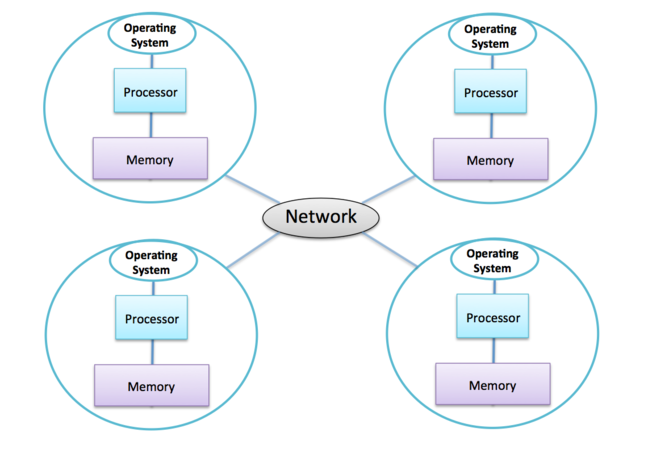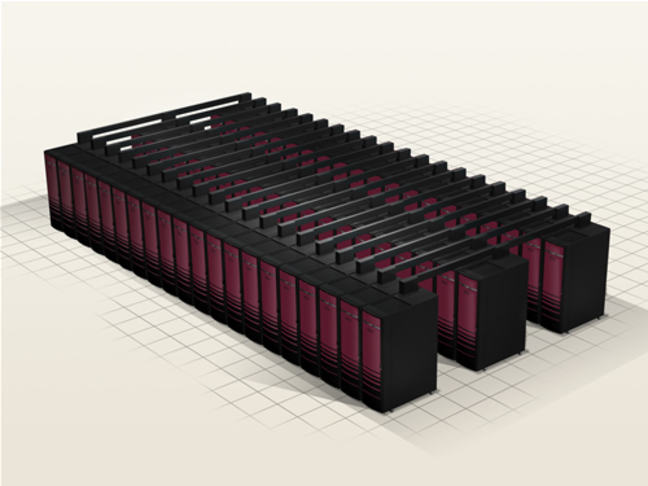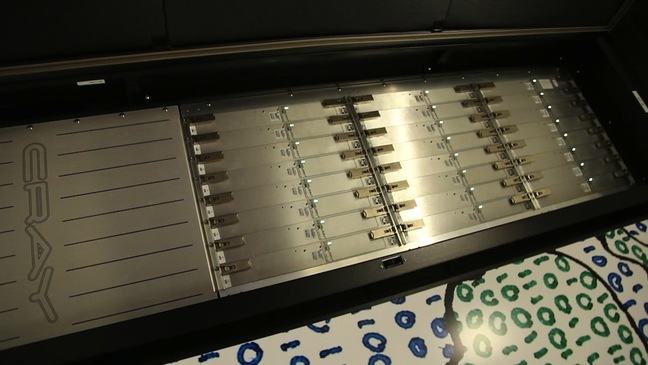Comparing the two appraoches
Looking inside your laptop
Transcript
0:11 - One of the things we’ve tried to emphasise when discussing supercomputer hardware is the way that supercomputers are very much built from commodity standard components– fairly standard– reasonably high end– but fairly standard processors and memory, but very large numbers of them. And so a supercomputer gets its power from having very large numbers of CPU-cores. However, it’s clear that the way that a supercomputer is packaged and put together must be very different from the way a commodity item, like a laptop, is put together.
0:39 - So what I’m going to do in this video is to deconstruct a laptop and also show you the inside of a board from a real supercomputer, and try to compare them so you can see what the similarities and differences between them are. So what I have here is a fairly standard laptop from the mid to late 2000s. And I’m going to take it apart, deconstruct it, to show you how it’s put together and kind of contrast the pieces that make up a standard laptop with a board from a supercomputer. So I would advise you, don’t do this at home, because it will destroy your laptop. But I’ve done this with a fairly old machines, so hopefully it’s OK!
1:12 - So the first thing is we don’t need the screen, OK? We’re not going to need the screen, so we can discard the screen. Secondly, we would not need the keyboard, OK? We don’t log into each node on a supercomputer and then type away, so we don’t need the keyboard. There’s some other packaging here. And we’re not going to need the battery.
1:33 - So we’re just left with the bare board here which has to all the components on it. Now we can see the components we’re going to need to retain for a supercomputer, which basically– the processor in the middle here, this is a Dual-Core Intel Processor. And actually there’s memory here as well. And the memory is actually on the other side if we turn this over– a little card here, which contains the memory. Well we can even see on the back here, there are components we really are not going to need when we have a supercomputer. There’s a wireless card interface here. There’s a disk here.
1:59 - Now the nodes on a supercomputer tend to be diskless, and there’s connectors here for other peripherals. We’re not need them when we put this into a supercomputer. So going back to the front again, I’ve pointed out the CPU and the memory, but there’s a whole array of other components here, which are all to do with what you need to do on a laptop. You need to drive the disk. You need to drive the screen. You need to drive the keyboard. There’s a touch pad here, and there will be things like Bluetooth and all the other peripherals, which you need to connect to a laptop. None of that circuitry is going to be required when we put this into a supercomputer.
2:32 - So hopefully, you can see– that although, we have the things we are going to need, the CPU and memory– there’s clearly a whole lot of other stuff going on here, which we’re not going to need when packing this up into a supercomputer.
We’ve explained that the hardware building blocks of supercomputers, memory and processors, are the same as for general-purpose computers.
But wait, ARCHER looks very different from your laptop! In this video David deconstructs a laptop so that, in the next step, we can compare its packaging to the specialist design of a supercomputer.

How similar is your laptop to a node of a supercomputer?
Transcript
0:11 - Having looked at the hardware that makes up a standard laptop, we’re now going to look at the equivalent hardware for a supercomputer. So this board comes from HECToR, which was actually the predecessor to ARCHER. HECToR was the UK National Supercomputer Service prior to the ARCHER Service starting. And this actually comes from a machine called a Cray XT4. So again, it’s a very similar architecture to the current ARCHER system. Just to explain some terminology, this is called a blade. which is quite heavy, quite difficult to lift up and down. And this is the unit to be inserted into the rack, into the cabinet. So you’ve seen in a typical supercomputer like ARCHER.
0:45 - We have these large cabinets about the size of a door and they have racks in them. And this is the unit which we insert into the rack which contains the processors. So I’m going to take the top off and we’re going to look at what it contains inside.
1:00 - So immediately, when we take the lid off, we can see it’s much more stripped down than inside your laptop. Only the essential components have been retained. So what we have here on this single blade is we actually have four nodes, one, two, three, four. And each of these, as we’ve described, will be running its own copy of the operating system. So a single blade effectively contains four separate computers. Of course, they’re linked through a network, but they’re all running their own copy of the operating system. Here you can see the processor. It’s a very standard AMD processor from the late 2000s, and it’s actually a quad-core processor. This actually has four CPU-cores on it.
1:39 - But the reason this node looks different from these other nodes is, we’ve taken off these heat sinks. The nodes are covered with these copper heat sinks to try and dissipate all the heat away. And the way that works is very different from on your laptop. Your laptop will have a small internal fan which will blow air through it. There’s no fan on this board. What happens is, externally there are large fans to blow air through the board to cool it. And these are very densely stacked, so you have to blow a lot of air through to keep them cool. You want the air to flow through very nicely.
2:09 - So you’ll see, for example here, this is a small baffle on the left to try and direct the air towards the core components. And it’s these nodes, these CPUs, which get very hot. And you maybe can’t see, but there are lots and lots of thin blades of copper here, which will get hot. And then the heat would be taken away by the air flowing through. So this blade, this board, is very, very stripped down compared to a laptop. The only additional things on this board, other than the CPUs are the memory. So you see with each node there’s a little memory card that’s attached here. Local - The memory here is local to each of the nodes.
2:43 - So as we described, the four cores on this quad-core node share all the memory, but the memory on distinct nodes is separate. You also need a network to connect all the nodes together. And that’s actually what these components here are. We haven’t removed the heat sinks, so you can’t really see them. But this is the networking technology here. The only other component of any interest on this board is this little controller here. And this is the master controller, which controls the operation of these other components. We’ve talked about the network. And you might ask, how are these physically connected together? Well, all the connections for the entire blade come in to all these pins down the side here.
3:22 - So all the traffic, all the data going in and out of the board will come in through cables connected to these ports here. So in conclusion, although the core components of this supercomputing blade, which are the processor and the memory, are just the same as we saw on the laptop, there are two main differences. First of all, this is much simpler. It’s been very much stripped back. And all the extra pieces we had in the laptop to do with driving the disk and the mouse and the Bluetooth and the screen have been taken away. So it’s much more simple. Because of that, we can actually pack things together much more densely.
3:58 - And here we have four complete computers all on the one board. And we’re able to do that because we can blow air through, with the external fans, to keep the whole thing cool. We can pack things much more densely than we could in the laptop. And so this entire setup has been designed specifically for the kind of things which supercomputers do, for doing numerical computations.
In the previous step you have seen a deconstructed laptop, in this video David takes apart a compute blade from the HECToR supercomputer.
Do you remember this diagram?

Having watched the above video, how would you modify it to make it more accurate?

HECToR Artist’s impression of the HECToR XT4 system © Cray Inc

HECToR’s compute blades

© iStock.com/BrianAJackson
What limits the speed of a supercomputer?
When we talked about how fast modern processors are, we concentrated on the clock frequency (nowadays measured in GHz, i.e. in billions of operations per second) which grew exponentially with Moore’s law until around 2005.
However, we have seen that a modern distributed-memory parallel supercomputer is made from many CPU-cores so there are two additional factors to consider:
CPU-cores are packaged together into shared-memory multicore nodes, so the performance of memory is important to us;
separate nodes communicate over a network, so network performance is also important.
Latency and bandwidth
It’s worth getting some ballpark feeling for memory and network performance so you can understand the factors that limit performance in practice. We’ll use the ARCHER system to give us some typical values. The two basic measures are latency and bandwidth:
latency is the minimum time taken to do anything at all, i.e. the time taken to transfer a single byte. You have to pay this overhead no matter how much data you are dealing with.
bandwidth is the rate at which you transfer large amounts of data.
A useful analogy is to think of people going up an escalator. The time taken for a single person to travel from the bottom to the top is the latency - if someone wants to use the escalator to go up a floor it’s going to take a minimum of around 10 seconds. However, this doesn’t mean that the escalator can only transport one person every ten seconds. Many people can be standing on the escalator at once, so if a large crowd of people is using the escalator then we might have several people reaching the top of the escalator every second. This is the bandwidth.
Numbers from ARCHER2
For access to memory (not cache! - access to cache is faster), the latency (delay between asking for a byte of data and reading it) is around 80 nanoseconds (80 x 10-9 or 80 billionths of a second). On ARCHER2, each node has a bandwidth of around 200 GBytes/second.
These figures might sound impressive, but remember that at a clock speed of around 2.7 GHz, each CPU-core is issuing instructions roughly every 0.4 nanoseconds, so waiting for data from memory takes the equivalent of around 200 instructions!
Remember also that, on ARCHER2, 128 CPU-cores are sharing access to memory so this latency can only increase due to congestion on the memory bus. They also share the bandwidth, so each CPU-core only really has just over 3 GBytes/second to itself. Again, at a clock frequency of 2.7 GHz this means that a CPU-core can only read or write a single byte per cycle in the worst case where all CPU-cores are accessing memory simultaneously.
A simple operation such as a = b + c processes 24 bytes of memory (read a and b, write c, each floating-point number occupying 8 bytes) so we are a long way off being able to supply the CPU-core with data at the rate it requires.
In practice things aren’t this bad, largely due to the availability of cache memory which has much smaller latency and much larger bandwidth. However, back-of-the-envelope calculations such as we have done above are enough to illustrate one of the most important points about supercomputing:
In reality, the performance of the processors in a modern supercomputer is limited by the memory bandwidth and not the clock frequency.
Interconnect Archer2
ARCHER2 has a very high-performance network with the following characteristics:
a latency (time to send a single byte between two nodes over the network) of around 2 microseconds (2 x 10-6 or 2 millionths of a second);
a bandwidth between 2 nodes of around 25 GBytes/second.
A 2 microseconds latency corresponds to around 5000 instruction cycles, so even communicating over a network as fast as ARCHER2’s is a substantial overhead. Although the bandwidth is shared between all the CPU-cores on a node, there are thousands of separate network links so, overall, ARCHER2 can in principle transfer many TBytes/second.
We will see next week that if we are careful about how we split our calculation up amongst all the CPU-cores we can accommodate these overheads to a certain extent, enabling real programs to run effectively on tens of thousands of cores. Despite this, it is still true that:
The maximum useful size of a modern supercomputer is limited by the performance of the network.
Large internet companies like Amazon and Google also use distributed memory architectures for their computational needs. They also offer access to their machines via something known as cloud computing. Do you think Amazon and Google services have the same requirements as we do in supercomputing? What limits the performance of their computers? Are they interested in Pflops?

© iStock.com/Stockfinland
Graphics Processors
When looking at the top500 list, you may have noticed that many of the world’s largest supercomputers use some kind of accelerator in addition to standard CPUs. A popular accelerator is a General Purpose Graphics Processing Unit, or GPGPU. Now we have covered how a modern multicore CPU works, we can understand the design of a GPGPU.
Supercomputers are largely built out of general-purpose components, which until recently meant using multicore CPUs because commercial demand was mainly driving the development of these processors for desktop and business computing. However, there is another market where processor performance is important: computer gaming.
Computer games are such an enormous market that it is worthwhile developing special processors, Graphics Processing Units or GPUs, to produce high quality 3D graphics. Although the details are quite complicated, you can think of a GPU as a very specialised multicore processor which has a very large number of simple cores. The cores can be simplified because they are designed for a single purpose: 3D graphics. Producing high-quality graphics at many tens of frames per second requires an enormous amount of data to be processed, so GPUs also have special memory which has significantly higher bandwidth than the memory normally attached to a CPU.
Accelerated supercomputers
Fortunately for those of us involved in supercomputing, the calculations required for 3D graphics are very similar to those required for scientific simulations - large numbers of operations involving floating-point numbers. So, although developed for a completely different purpose, GPUs look perfect for supercomputing:
designed for very fast floating-point calculation;
power-efficient due to the simple core design;
high memory bandwidth to keep the computational cores supplied with data.
The fact that the GPU architecture is inherently parallel - up to several thousand computational cores - isn’t too daunting as supercomputing has been all about parallel processing for decades.
Using GPUs for applications other than graphics is called General Purpose or GPGPU computing. With a relatively small amount of effort, GPU manufacturers can produce versions of their processors for the general purpose market. The supercomputing community directly benefits from the multi-billion pound research and development investments in the games market.
Programming a GPGPU isn’t quite as straightforward as a CPU, and not all applications are suitable for its specialised architecture, but one of the main areas of research in supercomputing at the moment is making GPGPUs easier to program for supercomputing applications.
Earlier we asked you to look at Piz Daint, which is accelerated compared to ARCHER2 by the addition of Nvidia’s GPGPUs. Use the sublist generator on the top500 page to check how many top500 systems use Nvidia accelerators. Do you see what you expected to see?
terminology Recap
Question 1
One of the differences between the shared and distributed memory architectures is that shared-memory systems are managed by only one ____ ____, whereas distributed memory systems have many of them (typically one per node).
Solution
operating system
Question 2
The two basic measures characterising the memory and network performance are: ____ and ____ . ____ is the rate at which you transfer large amounts of data. ____ is the minimum time taken to do anything at all, i.e. the time taken to transfer a single byte.
Solution
A) bandwidth B) latency C) bandwidth D) latency
Question 3
In the distributed memory architecture, the only way that two nodes can interact with each other is by communicating over the ____. In the shared memory architecture, different CPU-cores can communicate with each other by updating the same ____ location.
Solution
A) network B) memory

© iStock.com/Tutye
Game: Build your own supercomputer
In this game you are in charge of a supercomputer centre and you have to run lots of users’ jobs on your machine. Use your budget wisely to buy the best hardware for the job!
The main idea behind the game is to create a design of a supercomputer, balancing its components against budget and power efficiency.
Creating an efficient design may be difficult, however worry not! It’s a game after all. You are welcome to play it again at any time during the course. It may be interesting to see how your understanding of supercomputers improved.

Your design must handle jobs, and the completion of these provides money which can be further invested. As you progress through the levels the jobs become more complex (and lucrative) and additional components are available to be included within the machine. Besides passing through the levels, you can also obtain badges that are awarded for specific achievements such as a green supercomputer, profitable machine and the overall number of jobs run.
Follow the link to the game and start playing. We recommend doing a quick walk through first - click the ? icon on the landing page. You can summon the help menu at any point in the game by clicking on the Info icon, located in the upper right corner of the screen.
We hope you will enjoy your experiences as a supercomputing facility manager, good luck!
